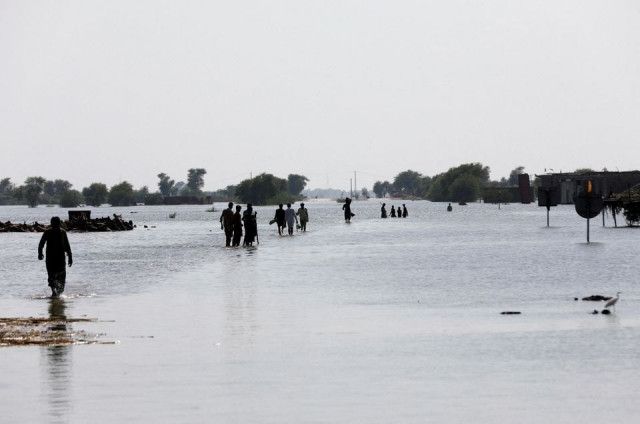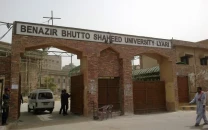Rain, flood threaten archeological, heritage sites
Sindh Culture and Antiquities Dept lists 19 sites of primary significance at risk in 10 districts

The recent monsoon rains and ensuing floods, which have caused colossal losses to life and property, have also wrecked the archaeological and heritage sites in Sindh.
In its 56-page report, the Sindh Culture and Antiquities Department has listed 19 sites of primary significance in 10 districts of the province which require immediate preservation. These sites are in Hyderabad, Jamshoro, Dadu, Khairpur, Sukkur, Ghotki, Thatta, Matiari, Sanghar and Benazirabad districts.
Although the Moen-jo-Daro is not mentioned in the report, local residents have shared footages and photographs of collapsed walls at the ancient site on social media.
On August 29, the Directorate General of Antiquities and Archaeology also floated a tender for "provision of emergency first aid to rain damaged archaeological and heritage sites". The scope of work implies that the department does not intend to carry out complete preservation of these sites.
Contractors will have to complete the works within six months. The tender, however, does not provide details of the sites and the budgeted amount reserved for their preservation.
Damages to the sites
According to the report, the fortification walls of Ranikot fort in Jamshoro have sustained serious damage during the rains. "Many portions of the wall have collapsed at Sann gate, Merikot, Shergarh and Mohan gate," states the report. The road leading to Merikot fort has also been washed away. "The skin of the wall has been weakened and badly broken due to water seepage," it adds. The walkway passage along the fortification wall has also collapsed.
The roof of Sehwan folk and craft museum in Jamshoro is also leaking and the ceiling's paint has peeled off. Humidity and moisture has eroded polish of the furniture. "The museum's overall condition is not satisfactory," says the report.
The situation, according to the report, is not different at Aamri mound and museum in Jamshoro where besides the structure, the furniture, solar panels, CCTV cameras, ceiling fans, batteries and even bulbs have been damaged.
Meanwhile, the department has expressed fear that a large part of the Pucca Qila fort in Hyderabad may collapse because it has already been weakened due to encroachments in the form of houses and shops built above and below the wall. "The wall is very weak. The bricks have crumbled and eroded," says the report.
The tombs of Kalhoro and Talpur dynasties and two historic mosques in Tando Fazl in Hyderabad have also been affected by the downpours. "The boundary wall built of mud has collapsed at several areas and its bricks are scattered all around," states the report. The portions of the wall that survived the torrential downpour are now threatened by water seepage and may also cave in.
The floor and walls inside the tombs as well as the graves in the courtyard of Talpur tombs in Hyderabad's Heerabad area are in a derelict state. Big cracks have appeared in the arched roofs of Tajar No. 1, 2 and 4. "The Tajars floor has been washed away and the graves have developed holes which will further damage them from inside," it says.
The Kashi tiles have pitched off at various sections of the wall of Mian Ghulam Nabi Kalhoro's tomb and the lime plaster is also falling off.
The Kotdiji fort in Khairpur district is surrounded by floodwater. Some portions of its fortification wall have collapsed, while the bricks are also crumbling.
The rain has inflicted considerable damage to the tourist attraction Satyan-jo-Aastan in Sukkur district, removing Kashi tiles, washing away glaze and sapping the bricks. Rain-induced ravages have also been witnessed at the archaeological site of Bhanbhore in Thatta district. Some parts of the fortification wall have collapsed, while the stone masonry has developed cracks.
The ancient Brahmanabad site in Sanghar district is also marooned, and the stagnant water is deteriorating the condition of the Stupa. Conditions at the tomb of Mir Shahdad in Sanghar are not different.
The boundary wall and bricks at the Buddhist Stupa in Benazirabad district have been damaged as graves and the main gate at the tomb of Mian Noor Muhamamd Kalhoro have also been wrecked. In all, there are 16 monuments in the tomb, of which 11 bore the brunt.
The dome at the tomb of Yar Muhammad in Dadu district may collapse as it has been damaged by the rains, according to the report. The kiosk on the tomb's backside has caved in. The rains have also damaged other monuments inside the tomb. The structure of Jamia Masjid Khudabad in Dadu district has also started crumbling.
Published in The Express Tribune, September 5th, 2022.



















COMMENTS
Comments are moderated and generally will be posted if they are on-topic and not abusive.
For more information, please see our Comments FAQ